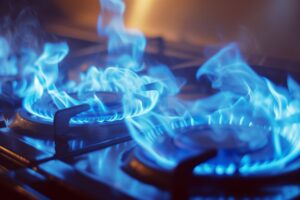Christmas cooks beware! Could Christmas dinner damage your health?
If you are involved in the cooking of Christmas dinner this year, you could be creating toxic indoor pollutants that can damage your health and that of others in your home.
Many of us will be looking forward to a family meal on Christmas Day, and whilst I have no wish to spoil anyone’s day, I’d like to bring up the subject of cooking pollutants.
We all know by now that indoor air pollution can be up to five times higher than that outdoors, as both indoor and outdoor pollutants can become concentrated in poorly ventilated spaces.
However, during the cooking of a roast dinner the levels of particulate matter (PM2.5) rise significantly, and a study by the University of Colorado, showed it to rise to 200 micrograms per cubic metre, higher than average levels of PM2.5 in Delhi, one of the World’s most polluted cities.
And cooking with gas raises the stakes significantly, as it’s a major source of both PM2.5 (microscopic particles suspended in the air) and higher levels of nitrogen dioxide (a harmful gas), than even a busy roadside. Any cooking method using gas appliances produces far more harmful particles and gases than non-combustion cooking methods like electric ovens, hobs and microwaves.
Cooking methods also vary in the amount and type of pollutants they cause.
Frying food, whether by gas or electric, releases a significant amount of harmful emissions into your indoor air, as oil heated to a high temperature emits compounds called polycyclic aromatic hydrocarbons (PAHs), which can be harmful to both eye and respiratory health. A comparative study of cooking practices showed that boiling produced the least PAHs, whilst grilling, roasting and frying produced the most.
The levels reached during the study breached World Health Organisation guidelines of 10 micrograms per cubic metre for over eight hours, as levels rose to thirty times that outside. Even making toast can send PM2.5 levels soaring. While gas flames and charred food churned out fine soot particles, others came from animal fat, cooking oils, grease and burnt-on foods in the oven, and on the pots and pans used in making the meal.

So, in short, cooking on gas (or other carbon fuels) can cause the build-up of nitrogen dioxide (NO2) and carbon monoxide (CO), in addition to the pollutants emitted through the cooking of the food itself. These cooking contaminants consist of, particulate matter (PM), and volatile organic compounds (VOCs) including, polycyclic aromatic hydrocarbons (PAHs) and formaldehyde (FA).
Those at most risks from air pollution are children, the elderly, pregnant women and those with existing chronic lung or heart conditions. So, when cooking your Christmas dinner this year be sure to open kitchen windows and use kitchen extractors to help filter out airborne contaminants.
However, as most extractor hoods do not use HEPA filters and many do not even extract the air outside, they just recirculate air without adequately filtering out fine particulates, you may wish to buy yourself a good air purifier as an early Christmas present.
Ideally, you would want a good extractor hood that vents air outside rather than recirculating it; cook with clean pots, pans and trays and make sure your oven is free from grease and burnt-on food; replace gas appliances with electric, induction hobs are just as easy to control than a gas flame and are much easier to clean and better for the environment, as well as your indoor air quality.
Ultimately, you may wish to consider installing a mechanical ventilation system, which introduces outside air into your home and extracts stale air through extractor fans. For most homes, positive input ventilation (PIV) unit would be the most cost-effective and easiest to install, however, new build homes would better benefit from mechanical ventilation with a heat recovery (MVHR) system.
According to a recent OnePoll survey, as a nation, we will consume a collective 250 million roast potatoes, and 264 million slices of turkey this Christmas. Food plays a key role in bringing people together and whatever you cook this Christmas, and for the rest of the year, I hope this information helps to minimise the risk of indoor pollution through cooking, which as well as having adverse health effects, can also increase the risk of virus transmission. So, ventilate, ventilate, ventilate and have a very happy and healthy Christmas and New Year.
John Lumb
www.evotechairquality.co.uk

















Yes, but presumably our hearts and lungs can cope with this amount of air pollution from hot fat cooking and perhaps some burnt food and so on for just a few days a year? Wouldn’t it be obvious if many were struggling to breathe, or whatever, on Boxing Day or straight after New Year? Isn’t it worse for those who work every day in (some) pub and hotel kitchens, and greasy takeaways, with inadequate ventilation? Do the staff there suffer from health problems related to the cooking contaminants and poor air quality? There ought to be a study on this. There have been some on hair-dressing salons, where the build-up of chemcials can be toxic. Same for those who work as cleaners in the hospitality sector and at airports. Ventilation and reducing the contaminants as much as possible really does seem to matter. But what if putting the extractor fans on full and opening windows brings in road traffic fumes and chimney smoke? Can’t win? Do hepa filters really fix the problem? You’d have to begin by checking the air quality level for these gases and particles and see how or if it changes. Could be done and then we’d see how good or bad it is.
Hi Chris
Thanks for the comments. Some people are more susceptible to air pollutants than others, like children and older people, pregnant women and those suffering chronic lung and heart conditions who are likely to react to cooking contaminants in the air they breathe. For others the more exposure they have, the more likely they are to develop lung or heart conditions in the future.
Commercial kitchens in the UK are regulated, and it’s a legal requirement to have effective extractor fans and adequate ventilation. Environmental Health Officers run regular inspections that include a kitchen’s extraction system, and they can ask to see maintenance documents as evidence.
Generally, UK homes will have either extractor fans that recirculate air or extract air to outside the building. If the unit recirculates air then we advise increasing ventilation in the room by opening windows. This will help clear air contaminants more quickly and air purifiers with HEPA13 filters certainly do help to filter out contaminants including PM2.5 and NO2 that may come from outside, as long as they are matched to the size of the room.
Regards Evotech Air Quality